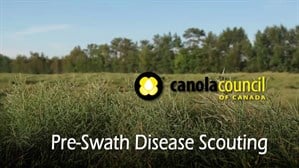July 23, 2014– Yield-robbing levels of disease will be easy to spot in canola fields now and through to harvest. This is a great time to start your pre-harvest disease scouting.
“Knowing what diseases you have at the end of the season is the only way to know how successful your disease management strategies have been this year and what you need to do for 2015 in order to be disease free,” says Clint Jurke, agronomy specialist with the Canola Council of Canada (CCC). “You only get one small window to do this well. Do not let it slip by.”
To help, the CCC has released a new pre-swath disease scouting video available on www.canolacouncil.org on proper identification including tips and close up views of typical damage from the major diseases. Watch the video here.
Three major stem diseases — blackleg, clubroot and sclerotinia stem rot — are more easily identified in the weeks leading up to harvest. Areas of the field with prematurely ripening plants and excessive lodging are signs that any one of these three diseases could be present. Here are tips to identify each:
Blackleg. Pull up diseased plants and use garden clippers to slice through the stem just below ground level. Look for blackened tissue inside the stem — a distinguishing feature of blackleg. If more than half the area of the stem is blackened, blackleg has likely reduced the yield of that plant.
Clubroot. Carefully dig up diseased-looking plants and look for galls on the roots. If clubroot is the reason for above-ground symptoms, the plant will have large galls at the base of the stem.
Sclerotinia stem rot. As the infected stem dries, it will become bleached or brown. Twist the infected stem. If it shreds apart, the disease is likely sclerotinia stem rot. Hard, black sclerotia bodies — similar in appearance to mouse droppings — found inside these bleached stems are a sure sign of sclerotinia stem rot.
Other diseases easier to identify in the weeks leading up to harvest are alternaria black spot and aster yellows. Alternaria tends to be more common in Polish canola and is rarely a problem in napus canola. Look for small black spots that move up the plant, eventually reaching the pods.
Obvious symptoms of aster yellows are the malformed bladder-like pods, which produce little to no yield. The disease can also result in normal looking pods that contain only a few misshapen seeds.
“When scouting for disease in the weeks leading up to harvest, it’s also important to keep in mind that what caused premature ripening, disfigurement or plant death may not be a disease at all,” says Manika Pradhan, disease diagnostician with Manitoba Agriculture Food and Rural Development’s crop diagnostic lab in Winnipeg. “Herbicide injuries and environmental effects, including heat, can cause some of these symptoms as well.”
Growers and agronomists looking for extra help in diagnosing canola issues can use the CCC’s Canola Diagnostic Tool at www.canoladiagnostictool.ca. Labs, such as MAFRD’s lab can also assist, but as Pradhan says, it’s best to bring in full plants, including roots, to help them make a proper diagnosis.
“Scouting fields now and right up to cutting is the best time to identify diseases because infected plants are often turning colour while the rest of the crop is still green,” Jurke says. “Assessing while swathing works too — getting off the swather to check problem patches — but waiting until the weeks after swathing to check stems is too late to make an accurate diagnosis.”
By then, all plants are drying down and distinguishing diseased plants and stems is more difficult. Also, various other fungi that feed on dead and dying plant material take over and often mask the crop disease present.
-30-
For more information, media can contact Canola Council of Canada agronomy specialist Clint Jurke or a CCC agronomy specialist in your region:
Clint Jurke, Western Saskatchewan
306-821-2935
OR
Angela Brackenreed, Manitoba
brackenreeda@canolacouncil.org
204-720-6923
Warren Ward, Eastern Saskatchewan
306-621-0630
Shawn Senko, Northern Saskatchewan
306-270-9307
Autumn Barnes, Southern Alberta,
587-425-0999
